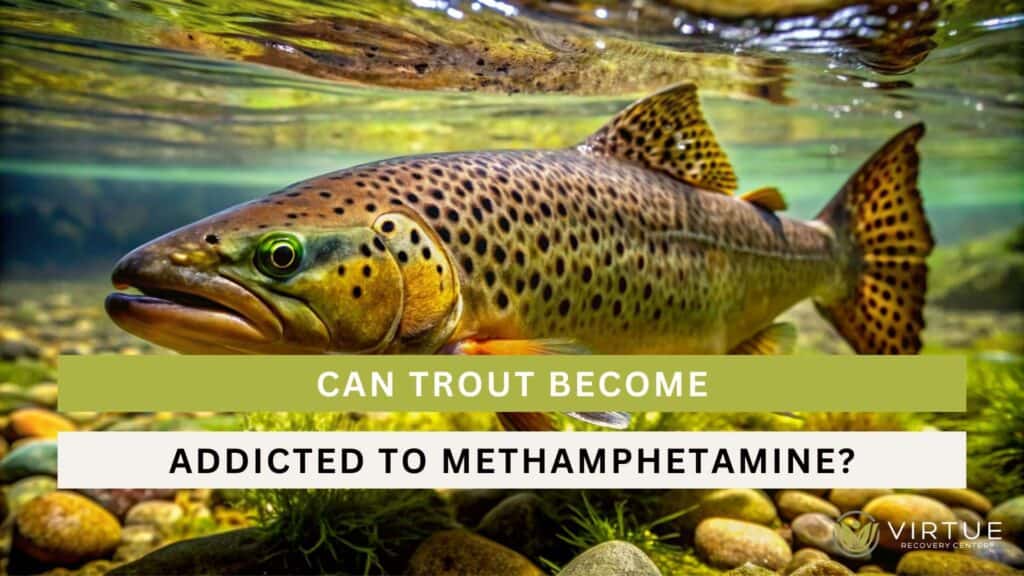
Table of Contents
Can Fish Like Trout Get ‘Hooked’ on Meth?
Yes, studies have shown that fish can exhibit addiction behaviors similar to humans when exposed to methamphetamine, such as preferring drug-laced water over drug-free water.Key Takeaways
- Methamphetamine pollution in waterways may cause trout to become addicted to meth.
- Brown trout exposed to meth in experiments showed signs of addiction.
- Wastewater treatment plants play a crucial role in preventing drug pollution.
- Research in the Czech Republic highlights the environmental impact of illicit drug use.
- Understanding addiction in fish can help mitigate pollution effects and improve water quality.
Introduction
Methamphetamine Pollution in Waterways
Sources of Pollution
Meth users excrete the drug through their urine, which then enters the sewage system. Wastewater treatment plants are designed to clean our water but don’t always remove every contaminant. As a result, residual meth and other drugs can be discharged into freshwater bodies. This pollution can reach levels that are surprisingly harmful to aquatic life.Levels of Methamphetamine
Fish experience substantial changes when exposed to methamphetamine concentrations that are even below detectable levels. Scientists have detected methamphetamine concentrations in polluted waterways, which affect aquatic organisms’ behavior and health. Research needs to explain how small concentrations of methamphetamine can create significant biological effects.Research on Trout and Methamphetamine Addiction
The Study in the Czech Republic
In a groundbreaking study, researchers in the Czech Republic set out to explore the potential for methamphetamine addiction in fish. Led by behavioral ecologist Pavel Horký, the team exposed brown trout to water contaminated with meth for eight weeks. This research aimed to mimic the conditions trout might encounter in polluted waterways.Experimental Findings
The results were startling. The fish who received exposure to methamphetamine displayed obvious addiction symptoms. The fish chose to drink meth-contaminated water instead of drug-free water during all preference tests. The observed behavior fits strongly with how humans show addiction signs, which demonstrates how methamphetamine has similar neurological impacts on fish and human brains.Effects of Methamphetamine on Trout
Behavioral Changes
The trout showed noticeable behavioral changes throughout the research period. The fish demonstrated a clear preference for drinking water containing methamphetamine, which indicated their development of a methamphetamine addiction. The research shows that methamphetamine exposure disrupts natural reward pathways in trout, similar to how addiction affects human reward systems.Physical and Biological Impact
Meth exposure caused direct impacts on both brain tissue structure and trout health status. The drug exposure led to structural and functional changes in the fish brain, which threatened their ability to survive and reproduce. The research showed that fish experience withdrawal symptoms when abruptly taken from methamphetamine exposure, which mirrors human addiction patterns.Implications of the Study
Environmental Impact
The presence of drugs like methamphetamine in our waterways is not just a human health issue; it’s an environmental crisis. Pollution from illicit drugs can disrupt entire aquatic ecosystems, affecting not just fish but the broader web of life that depends on clean water. Understanding these impacts is crucial for developing strategies to protect our water sources.Policy and Research Recommendations
The study demonstrates the necessity for developing better wastewater treatment systems that effectively eliminate drugs from sewage before they enter natural water ecosystems. Additionally, the research requires continuous support to create complete knowledge about the ecological effects of drug pollution. Complete solutions to pollution problems need both pollution source management and creative treatment approaches to reduce environmental hazards effectively.Conclusion
The idea that trout could become addicted to methamphetamine may seem far-fetched, but the research from the Czech Republic paints a clear and concerning picture. Drug pollution in our waterways has the potential to affect aquatic life in profound ways, mirroring the addiction processes seen in humans. Addressing this issue is vital for protecting both environmental and public health. If you or a loved one is struggling with addiction, give us a call at 866-461-3339.FAQs
Can fish get addicted to drugs like methamphetamine?
Research indicates fish develop addiction behaviors similar to humans after exposure to methamphetamine because they choose drug-laced water over drug-free water.How does methamphetamine get into waterways?
The main entry point of Methamphetamine into waterways stems from user excretion. The sewage system carries the drug until filtration failures allow it to reach freshwater bodies.What are the environmental impacts of drug pollution?
Drug pollution disrupts aquatic ecosystems while simultaneously affecting wildlife health and behavior and creates environmental harm through linked effects.How can we prevent drug pollution in water bodies?
Wastewater treatment must improve contaminant removal efficiency, regulate drug disposal methods, and enhance regulatory measures to stop drug pollution.What further research is needed on this topic?
Additional research must examine drug exposure effects on aquatic life and evaluate treatment methods and their ecological consequences on drug pollution.What human drugs were found in fish?
Scientists have identified multiple human pharmaceuticals in fish samples, which include antidepressants alongside antibiotics and cocaine and methamphetamine substances. Wastewater treatment facilities allow pharmaceutical residues to escape into aquatic environments because they do not completely remove these substances.What drugs are contaminating the ocean?
The ocean receives contamination from numerous pharmaceutical substances, including antibiotics, pain relievers, and hormones, together with illegal drugs, including cocaine and ecstasy. The wastewater treatment facilities fail to completely remove pharmaceutical manufacturing discharges and human waste products, which become ocean contaminants.Why should we care if trout are becoming addicted to drugs?
The occurrence of addictive drugs such as methamphetamine in water bodies leads to addiction behaviors in wildlife trout, which disrupts their natural behaviors and survival instincts. The ecological imbalances caused by drug presence in water bodies affect multiple species and their dependent aquatic ecosystems.Is There Any Connection Between Methamphetamine and Fish Like Trout?
Research suggests a surprising link between methamphetamine use and the prevalence of certain fish like trout in polluted waters. Areas contaminated by meth may lead to higher occurrences of methrelated skin conditions explained by exposure to toxic substances, affecting both aquatic life and human health.
Resources
https://www.cnn.com/2021/07/06/europe/trout-drug-addiction-scli-intl-scn/index.html https://www.bbc.com/future/article/20210716-why-fish-are-becoming-addicted-to-illegal-drugs https://www.nationalgeographic.com/animals/article/trout-can-become-addicted-to-meth-heres-why-thats-so-scary https://www.livescience.com/meth-addicted-brown-trout.html https://www.theguardian.com/environment/article/2024/jun/06/drug-pollution-wildlife-threat-aoeAre You Covered For Treatment?
At Virtue Recovery Center, we understand the importance of accessible care. That’s why we’re in-network with numerous private insurance companies, ensuring that your journey to recovery is supported from the start. Let us help you quickly and easily verify your insurance coverage. Begin your path to healing today.
- About the Author
- Latest Posts
Gigi Price( Clinical Director )
Gigi Price holds licenses as a Master Social Worker and Clinical Drug Counselor. She completed her master’s degree in Social Work at Texas State University. Over the last decade, Gigi has been dedicated to utilizing evidence-based practices to enhance patient care and treatment planning, resulting in positive, long-term outcomes for patients and their families. Her passion lies in creating a treatment environment where professionals collaborate to bring about positive change and provide a safe, trustworthy therapeutic experience. Patients can be confident in receiving top-quality care under her leadership.
In her role as the Clinical Director of Virtue Recovery Houston, Gigi conducted research to identify the most effective approaches for treating patients with acute mental health diagnoses, PTSD, and Substance Use Disorder. She then assembled a team of skilled clinicians who could offer various therapeutic modalities, such as Cognitive Behavioral Therapy (CBT), Dialectical Behavioral Therapy (DBT), Acceptance and Commitment Therapy (ACT), Somatic Exposure, Eye Movement Desensitization and Reprocessing (EMDR), and Cognitive Processing Therapy (CPT). Gigi takes pride in overseeing the development and implementation of Virtue Houston’s Treatment Program, which includes two specialized therapeutic curricula tailored to the unique needs of individuals struggling with mental health issues, addiction, and PTSD.
Key Takeaways Regular exercise reduces cravings and withdrawal symptoms. Physical …
Key Takeaways Veterans Day began as Armistice Day in 1918 …
Key Takeaways Proper nutrition plays a vital role in addiction …
Key Takeaways Long-term sobriety is achievable with evidence-based addiction treatment …
Key Takeaways Mindfulness and meditation improve focus, emotional balance, and …
Key Takeaways Family involvement greatly improves the success of addiction …


























